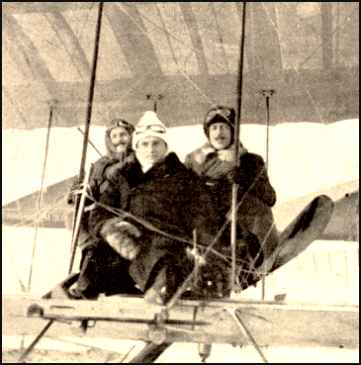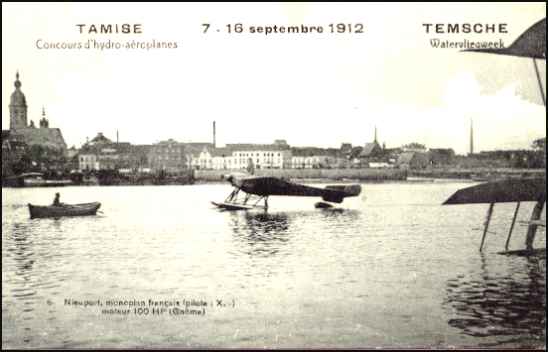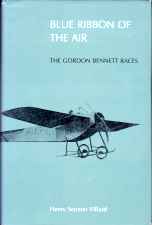
1889-1976 AKA Charles II Weymann |
 |
|
Photo and text from a newspaper report. Collection of Jean-Pierre Lauwers |
|
via email from Gilles Hudicourt, 11-7-06 At a certain time, a good part of the mothers family, who was very wealthy, moves to France and that is how Charles ends up in France Gilles Hudicourt |
|
The Daily Journal and Tribune, Knoxville, Tennessee: September 8, 1912, Transcribed by Bob Davis - 6-11-04 This Week's Program" The meeting embraces daily monoplane and biplane handicap races, a scratch biplane and monoplane race which is designed to give further demonstration of the skill of the Gordon Bennett drivers, and a 40-kilometer race for all types, handicapped. Other contests are bomb and mail throwing, accuracy landing contests from heights of 1,000 feet without a motor and similar events in which the skill of the operator is tested. This is the fourth time aeroplanes have been matched for the world's championship, as typified by the $10,000 silver trophy given by James Gordon Bennett in 1908 to be contended for annually by licensed pilots of the Federation Aeronautique Internationale. Twice before a single American entrant has driven his aeroplane ahead of his competitors and brought the silver trophy to America. Glenn H. Curtiss was the first winner, at Rheims, France, Aug. 28, 1909. His biplane finished the 12.4 mile race in 15 minutes, 50 seconds, or five seconds ahead of the looked-for winner, Louis Bleriot's monoplane. There were five starters, but only four of the flyers were able to cover the distance, which then was considered an almost impossible journey for an aeroplane. In New York on the Belmont park aerodrome, the second contest was held. The course had been lengthened to 100 kilometers (62.14 miles) and Claude Graham-White, England's best known airman, won in 71 minutes, 4 seconds, in the first 100-horsepower Bleriot monoplane built. Alfred LeBlanc, of France, led in the race in a similar machine, up to the last lap of the field, when he ran out of gasoline and in landing, crashed into a telephone pole and smashed his aeroplane. Graham-White's victory took the trophy for England, where it was contested for in 1911 on the Isle of Sheppy at Eastchurch, July 1. Charles Terres Weymann, sole American entrant, again went up in a 100 horsepower Nieuport monoplane and captured the trophy. His time for the 100 kilometers was 81 minutes, 30 seconds, a speed of over eighty miles an hour, then a world's speed record. Leblanc again after the world championship, had to content himself with second, being two minutes slower than Weymann. Speed alone determines the winner, there being no restriction on the construction of the aeroplane. Because of the high speeds obtained, few aviators have cared to enter, and in the three events held previously, a total of thirteen entrants only appear on the lists. This year the race has been lengthened to 200 kilometers (124 miles), and the course was laid out as an ellipse of 4.14 miles, requiring thirty laps to complete the races. In the French elimination trials, Jules Vedrinesmade a speed of 100 miles an hour, which established expectance as to what speed would be made by the choice machines of the six nations competing - America, England, France, Holland, Belgium and Switzerland. France designated Jules Vedrines and Maurice Prevost, pilots of Deperdussin monoplanes, and Andre Frey, who drives an Hanriot monoplane, as its representatives. England had named Claude Graham-White, Gustave Hamel and George Dyott, but it was certain until the last minute just who would make the actual flights. Belgium's representative, Charles Morok, died of typhoid fever a few days before the race, and Jan Wynmalen, who was to represent Holland, was so disappointed in the showing of his Oerts monoplane, he withdrew. Edmund Audemarn, Switzerland's representative, was not certain of entering, and as for America, the choice of pilot will not be definitely settled till the day before the race. An American defender prepared to carry a 100 horsepower motor, the largest aero motor ever designed. The hydroaeroplane, or airboat, aviation contests are the first ever held outside military competetions held in France for selection of government machines. The contests must continue five days during which races and contests are evolved to demonstrate how the multi-use machine may be guided on the water, be raised into the air and flown as a flying craft. In addition efficiency prizes have been offered, the contest being the numbers of passengers carried, the length of time one, two, and three extra persons may remain aloft, and other similar competetions." Bob Davis |
|
Personal Communication from Jean-Pierre Lauwers |
 |
|
Passengers, left to right: P. van Gaver & G. Neri Said to be a record-setting distance flight with two passengers. Photo and text from a newspaper report. Collection of Jean-Pierre Lauwers |
|
Personal Communication from Jean-Pierre Lauwers Born in Port-au-Prince, Haiti, August 2, 1889. Participated in the 1910 Reims av. meet in his Farman plane. In August 1910, participated in the Circuit de l'Est. In September, 1910, flew from Paris to Puy de Dôme with one passenger. The trip took seven hours. In May, 1911, according to my "Dictionnaire...", flying a Nieuport plane, he participated in the Paris to Madrid flight. In June, 1911, he participated in the flight from Paris to Rome. In July, 1911, he took part in the Circuit Européen. In 1912, he represented the USA in the 3rd Coupe Gordon Bennet...at Eastchurch, England. He was a winner flying a Nieuport at a speed of 125.663 km/h. He participated in the 1912 Hydroplanes contest at Monaco, St-Malo (both France) and the Temse 1912 Hydroplane contests here in Belgium. He stopped flying shortly thereafter. (Info from my Annuaire 1911 from the Aé.C.B. Closed circuit without passenger : speed 150 km WEYMANN England 1 h 11' 30''1/5 1/4 hours C.-A WEYMANN England 1911.07.01 : 31 km 862 1/2 hours id. 1911.07.01 : 63 km 477 |
 |
|
Copy of original Post Card Courtesy of Jean-Pierre Lauwers |
|
|
|
|
|
via email from Gilles Hudicourt, 9-10-04 In the meantime, I found these links that mention Charles Wyman. There is even a good picture of him. Gilles Hudicourt The Round Britain Race Monoplan Nieuport Monoplan Nieuport Weymann Postcard Édouard de Nié Port Les premiers appareils BREGUET La Coupe Schneider Paulhan-Curtiss Editor's Note: When on the site, scroll down to "Les hydro aéroplanes Paulhan-Curtiss" and click on it to go to the page. The article is in the pdf format so you will have to have the free Adobe Reader to view it. You will probably want to use the "FIND" function to locate the Weyman entry. |
|
via email from Gilles Hudicourt, 5-30-05 Here is one such link : Here is a French Article that says that the Charles Weymann automobile technology comes from aviation technology. You can get the full article for 2 Euros here. "As of the creation of Touring, Felice Bianchi Anderloni acquires the Weymann licence for Lombardy. Introduced in Italy by the Body Alessio of Turin, this technique, imitated aeronautics, was invented in France at the beginning of the Twenties per Charles Weymann. Its two major assets are the flexibility and lightness. The traditional body is equipped with fixed sheet plates in a rigid way on a wooden carpentry, so that the unit works under the effect of the vibr... This is an extract of the article which comprises 4 pages in its complete version. To reach it, you subscribe." Gilles Hudicourt |
|
via email from Gilles Hudicourt, 4-8-06 Gilles Hudicourt WEYMANN La Carrosserie Touring Charles Terres Weymann Car of the Month - January 2005 CHARLES TERRES WEYMANN RLH Bus Information Centre |
|
(Letter from Adj. Pilot W.B. Haviland from Pau, France.) If you prefer to read a transcription of the handwritten letter, you can find it by clicking on: |
 |
OF THE AIR by Henry Serrano Villard Product Details Hardcover: 224 pages; 1.0 x 6.5 x 9.5 inches List Price: $39.95 Publisher: Smithsonian Books (November 1, 1987) ISBN: 0874749425 |
|
TABLE OF CONTENTS: Chapter 1 THE AIRPLANE COMES OF AGE • 1908 1 Chapter 2 RHEIMS • 1909 21 Chapter 3 BELMONT PARK • 1910 53 Chapter 4 EASTCHURCH • 1911 95 Chapter 5 CHICAGO. 1912 129 Chapter 6 RETURN TO RHEIMS • 1913 169 Chapter 7 THE WAR YEARS • 1914-18 195 Chapter 8 THE LAST RACE • 1920 213 Epilogue 239 Appendix 1 251 Appendix 2 254 Notes 259 Selected Bibliography 265 Index 268 |
|
via email from Ray Weymann, 10-27-05 I am Ray Weymann; my grandfather, August Weymann was an older brother of Charles (I) Weymann, father of Charles Terres Weymann. I should say at the outset that I have no other direct knowledge about Charles Terres Weymann other than what is described in your web site. Also, my main interest is in learning something about the Weymann family history, having just returned from a visit to the town of Thann, in Alsace, where this family is from. However, I am eager to do some more digging. Prior to that, I wonder if you have any information on the following questions: As of 1912, Charles Terres Weymann is described as an American and later as "an expatriate living in France". Presumably, therefore, since he was born in Haiti, he must have immigrated to the U.S., and been naturalized. Do you have any information at all on what year he came to the U.S? He had two brothers, and I wonder if one or both came with him, and possibly his father and mother as well. Is there any immigration or naturalization document you are aware of? Do you have any information about where in the U.S. he lived? Since he became active in the car body business in France around 1921 he must have left the U.S. before then. Do you have any information about when and why he left the U.S.? Do you know whether he ever married or had any children? Do you know if he took up residence in England during the time of his bus company business? As I mentioned, I am interested in searching for documents, especially related to his stay in the U.S. and England, and any hints on the answers to the questions above would help to narrow the search. Of course I would share any information I find with you. Sincerely, Ray Weymann Editor's Note: All I know about Charles Weymann is what you find on this page. Ray has posed a number of questions, the answers to which would be very interesting to us all. If you can help him with any answers, I would be happy to forward your message to him. Thank you. |
|
This is what Henry Serrano Villard says in the book "Blue Ribbon of the Air" about the
Gordon Bennett air races: "Charles Weymann's life came to the close at the advanced age of eighty-seven in the summer of 1976. Chevalier of the Legion of Honour, recipient of the Croix de Guerre for the 1912-18 (sic) war, he remained an expatriate in France after winning the Gordon Bennett Cup for America in 1911. He applied himself to business pursuits, at which he was eminently successful, but he never lost interest in aviation. In 1975, the year before he died, he was fêted at a banquet by the Vielles Tiges, an association of aviation pioneers in Paris, and given its gold medal." |
|
If you have any information on this pioneer aviator please contact me. E-mail to Ralph Cooper |


|